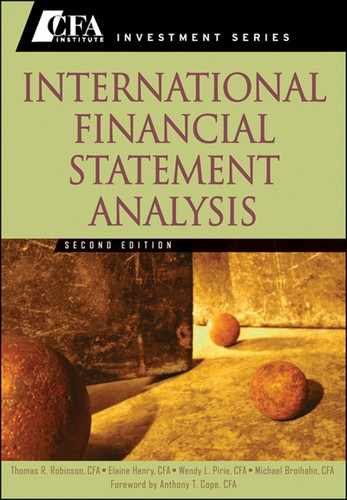Book Description
Up-to-date information on using financial statement analysis to successfully assess company performance, from the seasoned experts at the CFA Institute
Designed to help investment professionals and students effectively evaluate financial statements in today's international and volatile markets, amid an uncertain global economic climate, International Financial Statement Analysis, Second Edition compiles unparalleled wisdom from the CFA in one comprehensive volume.
Written by a distinguished team of authors and experienced contributors, the book provides complete coverage of the key financial field of statement analysis. Fully updated with new standards and methods for a post crisis world, this Second Edition covers the mechanics of the accounting process; the foundation for financial reporting; the differences and similarities in income statements, balance sheets, and cash flow statements around the world; examines the implications for securities valuation of any financial statement element or transaction, and shows how different financial statement analysis techniques can provide valuable clues into a company's operations and risk characteristics.
Financial statement analysis allows for realistic valuations of investment, lending, or merger and acquisition opportunities
Essential reading for financial analysts, investment analysts, portfolio managers, asset allocators, graduate students, and others interested in this important field of finance
Includes key coverage of income tax accounting and reporting, the difficulty of measuring the value of employee compensation, and the impact of foreign exchange rates on the financial statements of multinational corporations
Financial statement analysis gives investment professionals important insights into the true financial condition of a company, and International Financial Statement Analysis, Second Edition puts the full knowledge of the CFA at your fingertips.
Table of Contents
- Cover
- Contents
- Title
- Copyright
- Foreword
- Preface
- Acknowledgments
- About the CFA Institute Investment Series
- Chapter 1: Financial Statement Analysis: An Introduction
- Chapter 2: Financial Reporting Mechanics
- Learning Outcomes
- 1. Introduction
- 2. The Classification of Business Activities
- 3. Accounts and Financial Statements
- 4. The Accounting Process
- 5. Accruals and Valuation Adjustments
- 6. Accounting Systems
- 7. Using Financial Statements in Security Analysis
- 8. Summary
- Appendix 2A: A Debit/Credit Accounting System
- Problems
- Chapter 3: Financial Reporting Standards
- Learning Outcomes
- 1. Introduction
- 2. The Objective of Financial Reporting
- 3. Standard-Setting Bodies and Regulatory Authorities
- 4. Convergence of Global Financial Reporting Standards
- 5. The International Financial Reporting Standards Framework
- 6. Effective Financial Reporting
- 7. Comparison of IFRS with Alternative Reporting Systems
- 8. Monitoring Developments in Financial Reporting Standards
- 9. Summary
- Problems
- Chapter 4: Understanding Income Statements
- Chapter 5: Understanding Balance Sheets
- Chapter 6: Understanding Cash Flow Statements
- Chapter 7: Financial Analysis Techniques
- Chapter 8: Financial Statement Analysis: Applications
- Learning Outcomes
- 1. Introduction
- 2. Application: Evaluating Past Financial Performance
- 3. Application: Projecting Future Financial Performance
- 4. Application: Assessing Credit Risk
- 5. Application: Screening for Potential Equity Investments
- 6. Analyst Adjustments to Reported Financials
- 7. Summary
- Problems
- Chapter 9: Inventories
- Chapter 10: Long-Lived Assets
- Chapter 11: Income Taxes
- Learning Outcomes
- 1. Introduction
- 2. Differences Between Accounting Profit and Taxable Income
- 3. Determining the Tax Base of Assets and Liabilities
- 4. Temporary and Permanent Differences Between Taxable and Accounting Profit
- 5. Unused Tax Losses and Tax Credits
- 6. Recognition and Measurement of Current and Deferred Tax
- 7. Presentation and Disclosure
- 8. Comparison of IFRS and U.S. GAAP
- 9. Summary
- Problems
- Chapter 12: Noncurrent (Long-Term) Liabilities
- Chapter 13: Employee Compensation: Postemployment and Share-Based
- Chapter 14: Intercorporate Investments
- Chapter 15: Multinational Operations
- Chapter 16: Evaluating Financial Reporting Quality
- Learning Outcomes
- 1. Introduction
- 2. Discretion in Accounting Systems
- 3. Financial Reporting Quality: Definitions, Issues, and Aggregate Measures
- 4. A Framework for Identifying Low-Quality Financial Reporting
- 5. The Implications of Fair Value Reporting for Financial Reporting Quality: A Brief Discussion
- 6. Summary
- Problems
- Chapter 17: Integration of Financial Statement Analysis Techniques
- Glossary
- References
- About the Authors
- About the CFA Program
- Index
